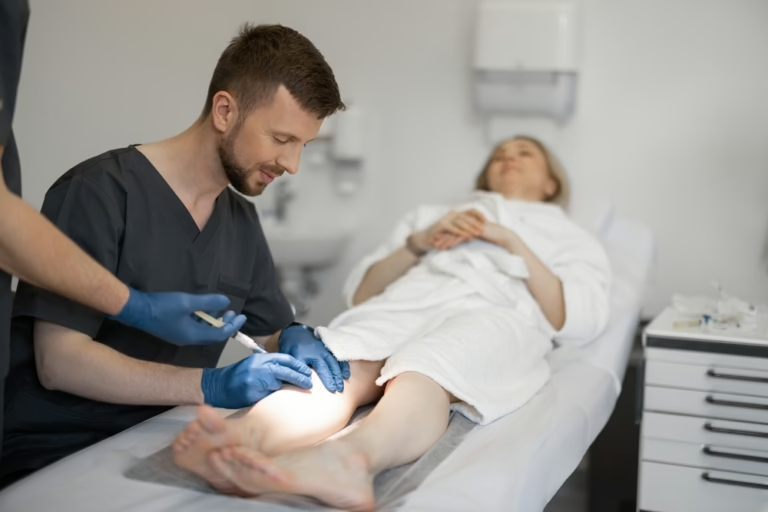Chronic venous insufficiency, or CVI, is a vein condition that’s caused by improperly functioning veins. It occurs when valves in the veins fail and allow blood to pool in a given section. It’s most commonly found in the legs and in people who sit or stand for long periods. When left untreated, the condition can become uncomfortable or painful and affect the leg internally and externally. The following are self-care tips that help you feel comfortable and manage the symptoms of CVI as well as prevent progression of CVI.
Wear Compression Stockings
Compression stockings are highly effective garments for reducing the discomfort and pain that’s associated with CVI. They deliver graduated pressure to the leg, which forces blood upwards towards the heart and prevents pooling in the lower legs. The compression is strongest at the ankle and looser as it goes up the leg towards the knee.
A compression stocking is a passive and active device because it works when you’re sitting and walking. The tension in the stocking stays the same no matter what you are doing, making it a simple solution for the condition.
Add Physical Activity to Your Day
You can help your heart work against CVI by exercising regularly to get your body moving, and the exercise doesn’t have to be strenuous. Getting out of your chair for a short walk and aquatic activities such as aerobics and swimming are excellent low-stress activities. They’re easy to accomplish, don’t require a strenuous routine, and are very beneficial to your overall health.
Exercise makes your body pump blood in response to the demand for oxygen. This makes it harder for the blood to pool in the legs, which gives you short-term relief from the symptoms of CVI. It also strengthens your heart, making it more effective at pushing blood through the veins when you’re resting. Managing your CVI symptoms is easier when your body is stronger.
Put Your Legs Up Whenever You Can
When you sit in a chair with your feet flat on the ground, blood pools in your lower legs and causes pain and discomfort. The easiest solution to the problem is to put your legs up, which helps the venous blood to flow in the correct direction toward your heart.
Finding ways to put your legs up when you’re sitting benefits your circulatory system and reduces pooling in the legs. For more information, check out our recent blog on “Tips for a Faster Recovery and What to Expect.”
THE CALF MUSCLE PUMP
The best way to get the blood moving in your leg is to activate “the calf muscle pump”. It’s easy to do. Just take your foot and step on the gas. Do this 10 times every hour if you’re sitting and can’t get up to walk around. If you’re standing and can’t walk around, go up and down on your toes 10 times. These moves will contract your calf muscle and push the blood up your legs
Avoid high heels whenever possible. Wearing high heels freezes the calf muscle pump and causes the blood to pool.
Drink Plenty of Water
Increasing your water intake prevents your blood from thickening and reduces sodium levels. Dehydration causes the blood to thicken, making it harder for your heart to pump blood through the veins. In turn, thicker blood easily pools in the compromised veins, worsening the condition.
Thicker blood can also lead to blood clots both the superficial ones and the deep ones. The superficial ones or phlebitis is very painful and a warning sign it’s time to schedule your appointment with Vanishing Veins asap. The deep vein blood clots or DVT can be life-threatening and require immediate attention.
Consuming salt causes the body to retain water in the legs, which can increase pressure in the veins. If the veins weaken further, the condition can worsen. Drinking more water helps alleviate both problems, reducing the symptoms and progression of CVI.
WATCH YOUR SODIUM INTAKE
Try to limit your sodium intake to 1500-2000 mg a day.
- The amount of sodium in 1/4 teaspoon of salt is 575 mg
- The amount of sodium in ½ teaspoon of salt is 1,150 mg
- The amount of sodium in 3/4 teaspoon of salt is 1,725 mg
- The amount of sodium in 1 teaspoon of salt is 2,300 mg
There is sodium in EVERYTHING. Limit foods with high sodium such as cheese, luncheon meat, and prepared foods, such as takeout or restaurants. You can ask for no salt on your food in a restaurant. A frozen “healthy” meal can have 1000 mg of Sodium.
If you have too much sodium, your body will hold onto water to try and dilute the sodium content in your body, by doing that, it will cause increased blood pressure and swelling. The most common area of swelling is your legs. However, many people also experience swelling in their hands and face.
Getting Medical Treatment for CVI
You have options when it comes to treating your CVI and getting long-term relief from its symptoms. At Vanishing Veins, we have various medical treatments proven to be effective for treating chronic venous insufficiency. Check out our Spider Vein Treatment in Bristol, CT, and other areas.
Contact us today to schedule an appointment with Dr. Greenwald and learn more about how treatment can help you feel better and take charge of your health.



